ARRI Alexa Minis Add Cinematic Imagery to Super Bowl LV Halftime Show
Story Highlights
With 90 million viewers and a setting at the heart of American culture, the Super Bowl Halftime Show has been called the biggest stage in the world. This year’s extravaganza, produced by Roc Nation, took place on February 7, 2021, in Tampa, Florida, with the cameras trained on Canadian pop superstar The Weeknd.
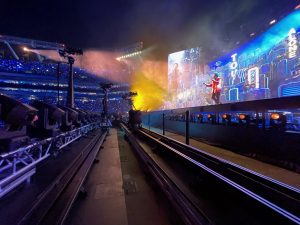 Behind the scenes, director Hamish Hamilton of Done and Dusted oversaw the production from a remote truck he describes as “quiet as a library” during the pressure-packed 12-minute spectacle. The halftime production is almost completely separate from the game coverage, which uses as many as 50 broadcast-quality cameras. Hamilton has directed the halftime show annually since 2010. Each year is different, he says. This time around, perhaps the most important difference was the decision Hamilton and his colleagues made to shoot mainly with large format cinema-quality cameras – in this case, eight ARRI ALEXA Minis and two ARRI AMIRAs. Hamilton says that the cinema- style, Super 35-gauge cameras opened many creative doors without adding workflow headaches or limitations.
Behind the scenes, director Hamish Hamilton of Done and Dusted oversaw the production from a remote truck he describes as “quiet as a library” during the pressure-packed 12-minute spectacle. The halftime production is almost completely separate from the game coverage, which uses as many as 50 broadcast-quality cameras. Hamilton has directed the halftime show annually since 2010. Each year is different, he says. This time around, perhaps the most important difference was the decision Hamilton and his colleagues made to shoot mainly with large format cinema-quality cameras – in this case, eight ARRI ALEXA Minis and two ARRI AMIRAs. Hamilton says that the cinema- style, Super 35-gauge cameras opened many creative doors without adding workflow headaches or limitations.
The shoot was the very first-time full cinema-quality cameras were used on the Super Bowl event. Hamilton says that the results have a feeling of epic theatricality. “The camera technology played an integral part in the scene that was set,” he says. “More than ever before on our Super Bowl productions, the sensor became a critical part of telling the story.”
Hamilton has been looking for ways to bring cinema-quality digital cameras onto the Super Bowl for years, but in 2021, a number of factors came together to make it possible.
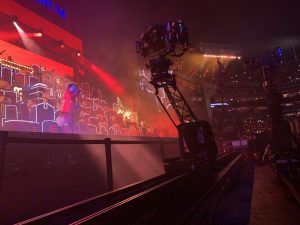 “With The Weeknd, we had an artist who could really benefit from a more cinematic aesthetic, changing the way a live concert would look to something more like his videos, and creating some looks that are slightly more extreme than a normal Super Bowl halftime show,” Hamilton says. “That all plays into the ARRI brand, and what those cameras are fantastic at doing. These sensors allow you to do so much more in terms of color, grading, depth of field and textures. We were given a lot of options for larger format cameras, but we felt that the aesthetic of the sensor that ARRI has created gave us the best image.”
“With The Weeknd, we had an artist who could really benefit from a more cinematic aesthetic, changing the way a live concert would look to something more like his videos, and creating some looks that are slightly more extreme than a normal Super Bowl halftime show,” Hamilton says. “That all plays into the ARRI brand, and what those cameras are fantastic at doing. These sensors allow you to do so much more in terms of color, grading, depth of field and textures. We were given a lot of options for larger format cameras, but we felt that the aesthetic of the sensor that ARRI has created gave us the best image.”
COVID considerations played into the decision tangentially. Instead of taking over the entire field with an instant stage setup, a fixed platform was built at one end of the stadium. That allowed for more thorough rehearsals beforehand with camera gear in position from the get-go. “With no crowd on the field, I didn’t have to use a load of Chapman cranes 50 feet away from the stage,” says Hamilton. “I could have the cameras closer to the talent, which I’ve never been able to do on this kind of show. That also played into the decision to use ARRI.”
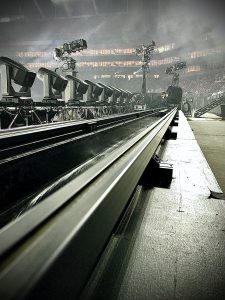 Prep included extensive conversations about maintaining an appropriate balance between a cinematic aesthetic and a sense of a live event energy.
Prep included extensive conversations about maintaining an appropriate balance between a cinematic aesthetic and a sense of a live event energy.
“We couldn’t go too extreme in the look,” says Hamilton. “After all, we’re in the middle of a football game! We didn’t want it to look like video or feel too processed or treated, but we had to make it feel live. At the same time, we wanted to give it a strong look with a sense of art, a sense of it living separately from the game, as entertainment.”
The team also carved out a relatively luxurious 45-minutes for dialing in LUTs and looks. “The ARRI cameras have such scope,” says Hamilton. “There are so many things you can do differently – such as the ability to change and create scenes and lighting cues,” says Hamilton. “We made sure to put this great technology in service of the story we were telling.”
The camera array was built around two primary positions, arranged in a stack formation and mounted on a track. The main closeup camera was at the downstage edge, with a slightly wider lens on the second camera getting a looser, full-body shot from a slightly lower angle. A third camera was mounted relatively close on a tower rig. All of the ALEXA Minis had dedicated focus pullers, a hallmark of cinematic camerawork, and a key to controlling depth of field.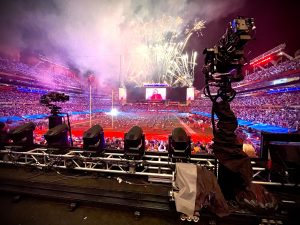
“Immediately, I had a great moving closeup of The Weeknd, with great depth of field,” says Hamilton. “We also had the choir= layered behind him – we really wanted to highlight the story of the choir. With that setup, I had great lenses and the right distance between him and the lenses, and great movements and layers. Of course, we also had Minis on Steadicam, and we also = had what we called the infinity room, placed underneath the choirstalls, sort of a room of lightbulbs. We decided we wanted to do that very aggressively. The idea is that it’s his descent into madness, given what the song is about. So we had him manhandle the camera, pull it into the room and push it away.”
These shots were done with an ARRI AMIRA mounted with a wide-angle ARRI /Zeiss Ultra Prime Rectilinear lens for a unique, impressionistic look. Images from the “infinity room” went viral, launching innumerable memes.
Hamilton did incorporate a few quick long shots from the broadcast cameras that were part of the CBS game telecast package. “As long as we stayed at the end of the lens, and we didn’t go too tight, with a good bit of grading, it didn’t jolt you out of the story,” he says.
Equipment companies are sensing the trends and coming up with innovative solutions for blending the worlds of cinema and broadcast. PRG, the rental company, supported the shoot with its 35Live! multicamera systems, which are camera-agnostic, allowing for integration of live, broadcast-style methods with digital 35 mm cinema cameras, including iris and lens control. ARRI recently introduced AMIRA Live, which is purpose-built for multicamera applications with a built-in fiber backend and Super 35-size sensor.
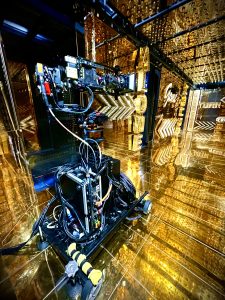 Looking back on the production, Hamilton says he’s surprised at how smoothly it went. “It’s a demanding show, and difficult to execute under any circumstances,” he says. “But through a lot of people’s hard work, it came off seamlessly. The night before, with all our camera gear set up, we had a violent Florida lightning storm, but there were no problems. You would not have realized that we had taken a radically different approach.
Looking back on the production, Hamilton says he’s surprised at how smoothly it went. “It’s a demanding show, and difficult to execute under any circumstances,” he says. “But through a lot of people’s hard work, it came off seamlessly. The night before, with all our camera gear set up, we had a violent Florida lightning storm, but there were no problems. You would not have realized that we had taken a radically different approach.
“I really hope that the success of our Super Bowl show furthers the use of this type of large format camera in entertainment,” he continues. “I hope we are getting to the tipping point where these cameras are embraced and encouraged. With each event where we come up with great images, more artists and directors are going to say ‘I want to do it that way.’ I think we proved that even in the most challenging workflows, if you put your mind to it, you can use ARRI cameras and get a sensational program. You clearly get the benefit. It’s a whole new level of aesthetics, of production values, of storytelling. It took The Weeknd show into the realm of cinema and theater. The whole language of it felt very different – more dramatic, and more emotionally rich.”
